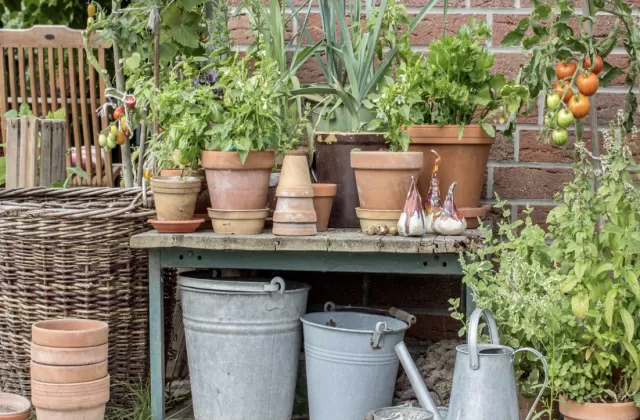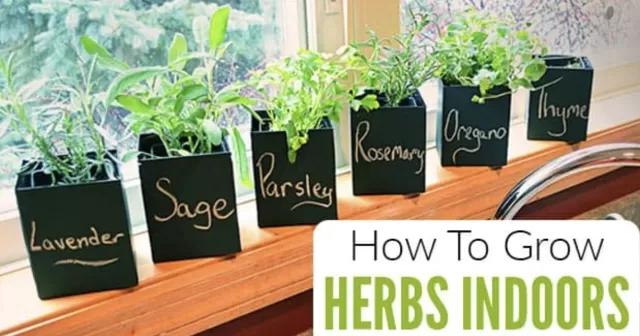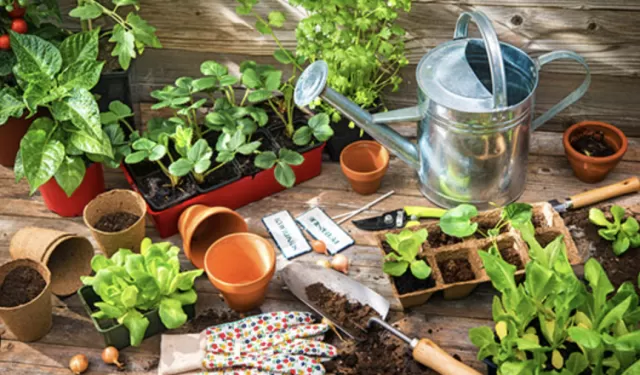Growing using fresh herbs can take a dish to the next level, but purchasing them from the grocery store can be expensive. Dried herbs, on the other hand, lack the same flavor intensity. If you don’t have outdoor space to garden or want to continue growing herbs through the winter, starting an indoor herb garden is an ideal solution.
Indoor herb gardens offer not only a steady supply of fresh herbs for cooking but also add wonderful fragrance and color to your home. According to Janice Cox, author, and education chair for The Herb Society of America, “Plants make us happy.” Scented geraniums, lavender, and rosemary not only smell pleasant but also provide a mental boost. Growing fresh herbs indoors is a simple and effective way to enhance your indoor living space while also promoting your well-being.
Mastering the Art of Caring for Your Indoor Herb Garden

With the right container and some care, many herbs can thrive indoors.
However, it’s essential to provide the proper growing conditions, just like any other indoor plant. Peggy Ricco, chair of the Potomac Unit of the Herb Society of America, suggests, “Learn the plant’s light and humidity requirements, but also learn how to harvest the foliage.
” The biggest challenge is providing adequate light since indoor light is typically less intense than outdoor light. While shade-tolerant herbs such as mint and chives may thrive near a window, sun-loving herbs like basil, dill, savory, oregano, sage, and thyme may require supplemental lighting.
Different herbs have different growing requirements.
Some prefer more moisture, while others prefer less. Some prefer cooler temperatures, while most prefer warmer temperatures.
To optimize growth, choose herbs that match the growing conditions in your home, and provide them with individualized containers and care.
Light: Most herbs need at least six hours of sunlight daily, making a south-facing window or other sunny location ideal.
When additional lighting is necessary, Peggy Ricco, chair of the Potomac Unit of the Herb Society of America, recommends functional and decorative light stands, such as the sleek and modern Oslo Grow Lights line from Gardener’s Supply Company. With LED lights that attach via magnets, they serve as furniture for your plants.
Water: Herbs have varying water requirements.
Woody herbs, such as oregano, sage, rosemary, and thyme, prefer drier soils, while basil, cilantro, mint, and parsley need more moisture. “Most people tend to overwater their plants, especially if they are indoors and you see them every day,” says Janice Cox.
Water herbs when the soil surface feels dry and avoid letting plants or pots sit in standing water. Placing a tray of pebbles under pots can catch excess water and provide additional humidity as the water evaporates.
Fertilizer: During the summer months, fertilize herbs once a week with a water-soluble fertilizer diluted to 1/4 the rate indicated on the packaging.
Herbs grow less actively during winter and do not require fertilization. Over-feeding herbs can cause them to lose flavor, so it’s best to water plants well before fertilizing and go easy on the fertilizer.
Harvesting: Clipping herbs for cooking helps keep plants productive.
Most herbs can be harvested once they reach a height of at least six inches. “For some herbs, you can just snip a few leaves at a time,” says Ricco.
“Some can tolerate a buzz cut and come back, while others need a deep cut into the plant to encourage bushiness. ” To maintain healthy and productive plants, avoid removing more than one-third of the plant at once.
Top Herbs for Growing Indoors

Many commonly used kitchen herbs can be grown easily indoors, including basil, chives, dill, parsley, and cilantro.
Annuals such as sweet marjoram and chervil are also great for indoor gardening. Additionally, a wide range of perennial herbs, such as sweet bay trees, rosemary, and thyme, can be grown indoors.
When selecting herbs to grow, consider which herbs best complement the foods you enjoy cooking.
According to Janice Cox, it’s also crucial to think about how you plan to use the herbs. “Are you growing them to add to your indoor plant collection? As a handy culinary ingredient or to create your own body care or craft products?” These considerations can help you select the best plants.
It’s also important to evaluate the growing conditions in your home.
If you keep your home cool, you may want to consider cold-tolerant herbs such as chervil, chives, mint, oregano, parsley, sage, and thyme. While most herbs require bright light to grow well, chervil, chives, parsley, and plants in the mint family, such as lemon balm, can tolerate lower light levels.
Get Growing: How to Start Your Own Indoor Herb Garden

To start an indoor herb garden, Peggy Ricco recommends purchasing plants, particularly annuals like basil and dill, or taking cuttings from existing perennial plants in your garden, such as thyme, oregano, and sage.
Most popular herbs are available at local garden centers or grocery stores. Once you have potted them, you are ready to start growing.
You can also start many herbs from seed, but annual herbs like basil, parsley, cilantro, chervil, and dill require longer growing times before they can be harvested.
Some herb seeds, such as parsley, lavender, thyme, and rosemary, take longer to germinate, increasing the risk of disease. Herb seedlings also require careful moisture control and at least 12 to 14 hours of bright light daily, which can be provided by supplemental lighting.
Basil, chives, and dill are among the easiest herbs to start from seed if you’re up for the challenge.
If you have an outdoor garden, you can start many herbs from divisions or cuttings from established plants.
Basil, lemon balm, mint, rosemary, sage, sweet bay, and chives are some examples of plants that root easily from cuttings. Dividing a clump of chives is a great way to start an indoor pot.
Lemon balm, mint, oregano, sweet marjoram, and thyme can also be divided and brought indoors. When bringing plants and cuttings indoors, be sure to isolate them from other houseplants for a few weeks to ensure they are free of pests.
*The information is for reference only.